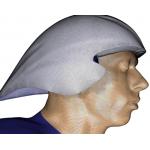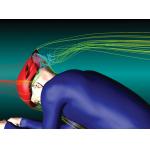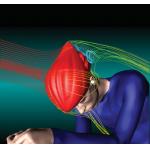Latest News
April 1, 2006
By Erin Hatfield
| Reverse engineering and CFD analysis help the British Cycling Team sprint to Olympic medals.
The new rule required that only helmets passing a formal safety test in an accredited laboratory could be used in Olympic competition. Since some of the helmets the team planned on using did not fit those specifications because they were designed primarily for speed rather than protection, the team decided to test helmet designs for aerodynamic efficiency from among those that passed the safety regulations. Four helmets were selected for testing from manufacturers to which the team had access.
The team turned again to SERG’s Dr. John Hart for a last-minute CFD analysis. Hart ruled out modeling from scratch with CAD as there was not enough time and CAD is not well-suited to creating the organic shapes required for accurate modeling and CFD analysis of the helmets and athletes. Instead, Hart decided to capture athlete and helmet geometry with 3D Scanners’ ModelMaker X70 noncontact 3D laser. The scanner, fitted to a FaroArm, would capture the shapes, then Hart could merge the scans and create a NURBS model of the data in Geomagic Studio. Scanning the helmets was relatively straightforward. Each helmet took approximately 25 minutes to scan depending on the complexity of the design. The FaroArm was moved around the object, capturing point-cloud data and depth information. SERG planned to capture data from the athletes by scanning them in different racing positions: one aerodynamic posture with the cyclist looking ahead and one where the head is down in a sprint to test more fully the effect of the various helmet shapes. Because of the time crunch, however, Hart did not have access to a cyclist; he had to scan a colleague for the human geometry. The subject was scanned over the course of two hours, allowing for rest breaks during scanning. To help eliminate issues arising from sudden movements during the process, completed scans were broken into sections that followed closely in succession—upper arm, lower arm, hand.
Refining Complex Scan Data Point-cloud data collected from the scans of the four different helmets was imported into Geomagic Studio, a reverse-engineering solution for generating models for accurate CFD analysis and custom manufacturing. Geomagic Studio automatically aligned the scan data and a polygon mesh was applied. The model was cleaned to remove holes and defects, and patches were placed over the polygons, outlining the positions of the NURBS surfaces. Hart handled scan data from the human subject in much the same way, except additional work had to be done to reduce noise and align the data due to subtle movements from Hart’s colleague as he was being scanned. Hart used Geomagic Studio’s noise-reduction feature, as well as editing and filter tools, to refine the human model. He then used the software’s polygon geometric reconstruction functions to fill in missing data such as body hair and eyebrows that weren’t captured due to laser scatter.
“Geomagic Studio’s editing tools and ability to handle large, complex data sets made it a great match for this project,” says Hart. “We used the tools to refine scan data around the ears and in tight gaps, which enabled us to maintain a high degree of geometric realism on such a challenging human scan with nearly six million raw data points.” Visualization That Proves Results The STEP file containing each helmet design and the human geometry was meshed for CFD analysis in Fluent Gambit, where Hart also generated a flow domain around each model. The meshes ranged from two to seven million cells, depending on the geometry. Wherever possible, prism cells were generated over the surface geometry to capture boundary-layer flow features in detail. CFD analysis, which incorporated data on boundary and physical conditions acquired from a previous British Cycling project, was conducted using Fluent.
The SERG team imported CFD results into CEI’s EnSight software, which produced highly detailed flow visualizations showing the aerodynamic properties of the helmets. SERG chose to concentrate on the drag and lift forces in the simulations, using isosurfaces to show wake structures and particle streamlines to visualize swirling and recirculating flow paths.
Hart and his colleagues used the EnSight images and animations to reinforce the hard data results from the Fluent simulations and to help the engineers understand the flow physics that create the lift and drag forces. Based on the results, SERG was able to recommend an optimal helmet style that reduces aerodynamic drag and lift. “The quality of the model geometry from Geomagic Studio and realistic color renderings and surfaces we applied in EnSight enabled us to incorporate a great deal of realism in the visualization,” says Hart. The optimized bike design and later helmet recommendations from SERG have been credited with helping contribute to the team’s best-ever Olympic medal haul. The team won two gold medals, a silver, and a bronze in Athens, but they’re not done. SERG is once again working with the team in preparation for the 2008 Beijing Summer Olympics. Product Information EnSight |
Subscribe to our FREE magazine, FREE email newsletters or both!
Latest News
About the Author
DE’s editors contribute news and new product announcements to Digital Engineering.
Press releases may be sent to them via [email protected].







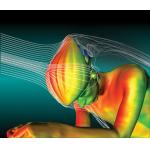
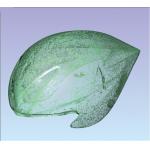
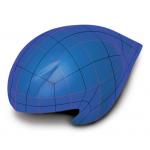
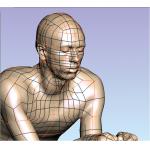 ‹ ‹ The subject was scanned over the course of two hours. Completed scans were broken into sections to help eliminate issues arising from sudden movements during the process.
‹ ‹ The subject was scanned over the course of two hours. Completed scans were broken into sections to help eliminate issues arising from sudden movements during the process. 